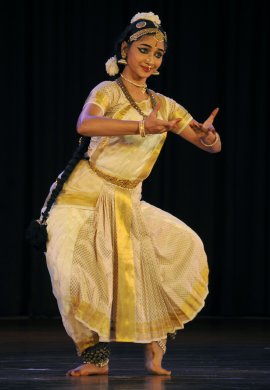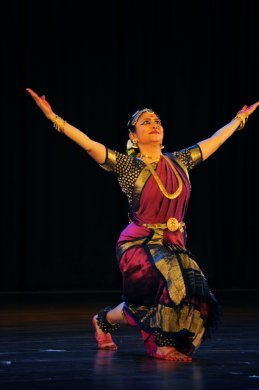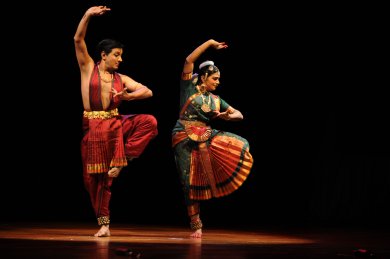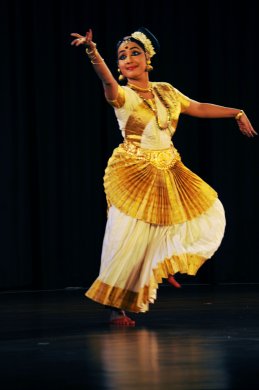
|   |

|   |
The Madras Music Academy Dance Festival - Day 5 - Veejay Sai e-mail: vs.veejaysai@gmail.com Photos: Thanthoni January 14, 2017 Positive and energetic  The fifth morning of the Academy’s festival opened with a solo performance of N Harinie Jeevitha. She is a disciple of Guru Sheela Unnikrishnan who presented a group from her dance schools only a few days earlier in the same festival. This was Harinie’s debut in the Academy’s festival. Harinie began her performance with an alarippu composed by Guru Bharadwaj set to chanda talam. Harinie was full of life and energy when she arrived on the stage. Dressed in cream and gold, her aharyam was impeccable for her appearance. The structural components of this alarippu were interesting. The whole beat cycle is seven and half maatras. This cycle was divided into two segments. A trisra triputa followed by a trisra chapu. While that being the basic structure of the alarippu, it was full of energy. For those who can understand the details and nuances of talam, this was a pleasure to watch, and keep the count along. This was enough to establish how strong and well-groomed Harinie was in her talam and laya. But for most of the others, this was unexplained and new. Understanding the intricacies of various talam calculations is not everyone’s deal either. Gurus must take the initiative to orient those interested in this matter. For her main piece, Harinie chose to present the varnam “Sakhiye inda velayil” set to ragam Anandabhairavi and adi talam, a classic Tanjore Quartet composition. Addressed to Rajagopala of Mannargudi, the nayika pines for union with him. Trying to convince her friend to bring him to her, she prepares a bed of flowers in her love and infatuation for him. Harinie’s performance had the charm of the old world, not aggressive or over dramatized like many other dancers do these sancharis. The only time she showed her technical prowess was in her deft handling of jatis. Guru Sheela Unnikrishnan on the nattuvangam was outstanding. With clean lines, crisp cut adavus, Harinie’s dance shone through this piece. She continued her performance with the famous “Natanam aadinar” set to khanda jaati ata talam. The chorography began with Harinie coming on to the stage and looking at a door of light that signified the garbhagriham of the temple, with her back to the audience. After a vision of Nataraja she began her dance. She opened with a viruttam on Shiva. Except that it was the wrong Shiva from the wrong kshetram being sung about. The viruttam was excerpted from the ‘Kashi Vishwanatha Ashtakam’ of Adi Shankara. After this she continued into the rest of the song. The dola hasta was not shown the way it usually is, which once again raised questions on the Melattur school of Bharatanatyam. Do they show the dola hasta in a different way from others? On the stage stood a statue of Nataraja. Surely their style couldn’t have been that different from this ancient iconography of Shiva! Guru Sheela Unnikrishnan has much to explain about the vocabulary of her style - the hastas, the pada bhedas and more. G Srikanth’s singing was good. Guru Bharadwaj’s mridangam accompaniment was excellent. Harinie concluded her performance with a thillana in ragam Bihag, a composition of Mysore Venkatagiriyappa. Harinie is a very promising soloist. She has the charm and grace of the old world and yet keeps her dance very firm-footed in the now. Her knowledge of talam is impressive. If she works on a few things, she will go a long way. Confusing elephants and renaming regulars  The second performance for the morning was a solo by Pavithra Srinivasan. Her fairly long bio in the Academy’s brochure said she had her arangetram in Kalakshetra style but became a student of Rhadha in Vazhuvoor style, a student of Nirmala Ramachandran in Pandanallur style and Bhagavatula Seetharama Sarma and Kalanidhi Narayanan. She currently trains under the Dhananjayans and is back to the Kalakshetra style where she began. Pavithra began her performance with the famous composition of Dayananda Saraswati, “Mahaganapatim manasa smarami’, an invocation to Ganesha. Choreographed by her, the usual stories about Ganesha were wonderful to see, except Pavithra put her hands above her head to show the Kumbha Sthala or the forehead of an elephant to portray an elephant on rut. The descriptive terms of this elephant would be a ‘Madha Gaja’, an elephant on heat. This isn’t exactly the way the elephant headed god Ganesha is portrayed. This misinterpretation was a rather big faux paus in the whole piece, which she repeated. She continued her performance with a varnam which was announced as per the dictates of her Guru V.P. Dhananjayan as a ‘Nrithyopaharam.’ The Ninda Stuti “Aadum mayil vahana” by Periyasami Thooran set to ragamalika and talamilaka was an excellent choice. Choreographed by her guru, it opened with a Reetigowla set by T Rajagopala Sharma. The whole plot is in the form of a conversation between two friends in love with Muruga. One is running the other’s ideas down by poking fun at Muruga’s father and mother. A superb selection. If not over-cluttered with too many jatis that broke through the story to give large gaps, the rest of the elements were presented well. Shanta Dhananjayan’s nattuvangam is one of the best we have around. Pavithra chose not to dance what was listed in the Academy brochure. Instead she presented a padam composed and choreographed by her guru, set to ragam Neelambari and misra chapu talam, the poignant tale of a nayika who is waiting for her lover to return. However the viraham of the nayika didn’t come forth in Pavithra’s abhinayam. One would expect more of her involvement with the piece before she presented it. Nellai Kannan went off track several times in his mridangam accompaniment. She concluded her performance with a thillana (announced as a ‘Nrittangaharam’) in ragam Kuntalavarali composed by Dr Mangalampalli Balamuralikrishna. Pavithra’s performance at the Academy was an improvement over whatever she presented last time. She needs to work a lot more on convincing abhinayam to enhance her performances. Two to Tango  The evening performance was by the couple Srikanth Natarajan and his wife Aswathy. For those who aren’t aware, Srikanth hails from the family of the famous Bhagavata Mela in Melattur. He trained in Bharatanatyam under Dr. Saraswathi and later Dr. Padma Subrahmanyam where he learnt her style of Bharatanrithyam. Aswathy learnt Mohiniattam from her mother Guru Kalamandalam Saraswathy and also trained in Kuchipudi and Bharatanatyam. Srikanth and Aswathy as a dancing couple have performed at an earlier occasion in the Academy festival. They opened their performance with an invocatory kauthuvam in praise of lord Shiva the head of the golden hall or Kanakasabhapathy. Set to music by G Vijayaraghavan, this was stitched along with a Thevaram of Thirugnana Sambandar, “Karpanai.” From the very beginning both Srikanth and Aswathy were seen dancing with a good energy. The main piece of their performance was the famous Swati Thirunal varnam “Saveriha Tanuja” in ragam Saveri. The varnam is a known one. What was worth observing was the way Srikanth and Aswathy choreographed it using their new ideas. Taking on roles in different sancharis, their narrative skills were closer to theatre than most other dance couples have. That Srikant hails from the Melattur Bhagavata Mela lineage and his exposure into theatre could have been an inspiration towards his choreography in Bharatanatyam as well. We saw several sequences, like the famous tale of Abhirami Andhadhi, the story of Abhirama Bhattar and several others enacted out in great precision. In their nritta sequences, a bit slow, but they didn’t make it boring. In the second half of the varnam which they began with the charanam “Dhaaradhara chigura,” while a lot of the mirroring movements in the choreography could have been avoided, they danced with an easier flow in the svara sahityam areas. Srikanth also kept getting distracted with his baggy pyjama costume. Jayashree Ramanathan’s nattuvangam support provided able scope for them to explore the stage with its generous expanse. The performance continued with a solo of Srikanth. Presenting the famous Purandhara Dasa kriti “Maneyolagaadu” set to Nalinakanti ragam and adi talam, the story of Nanda telling Krishna not to go out and play but stay at home instead. Some of the sancharis showing Krishna milking cows and drinking milk directly from its udders were a bit odd. Why would Krishna peep into a cow’s udders and look like it was a municipal pipeline! Hariprasad’s singing kept breaking the sahityam at odds. Without these odd sequences that interfered into the choreography, the piece was a good choice to present. After this, Aswathy presented a solo javali “Netru varen endru,” a composition of Dharmapuri Subbarayar. The tale of a lovelorn nayika complaining to her friend that the lover has not kept a promised date, Aswathy’s abhinayam was sober and subtle. The couple danced together with great coordination. There were places where one of them would slow down and the other would balance. There were times when both were slow and other times when both exhibited their prowess in good nritta. Srikanth and Aswathy are good dancers, undoubtedly, but it would require much more energy from their side to make a show beyond good. The Enchantress’s ode to a maestro  The finale of the day was a solo Mohiniattam presentation of Neena Prasad. Neena needs no introduction to the world of dance or to Mohiniattam community. She is the reigning queen of Mohiniattam, both as a performer and an academic and research scholar. Neena began her performance with a cholkettu in Hamsadhwani ragam set to a khanda jaati triputa talam. This was introduced to us with a virutam in the form of “Brahmanandam parama sukhadam, kevalam dhyana murtim.” The melodious combination of Murali Krishnan’s veena and Arun Das’s edakka accompaniment set the mood for the rest of the performance. Slow and graceful, with the lateral movements of the dance form, Neena covered the expanse of the stage. She continued to warm up with the famous “Shankara srigiri” before getting into the main piece of her performance. Shyama Shastri’s famous Swarajathi in ragam Bhairavi, “Amba Kamakshi” was one of the finest one could have seen in a long time. The Swarajathi is difficult enough for a pure Carnatic concert. Weighed down by a sensitive ragam like Bhairavi and the poetic lyrics of Shyama Shastri that invoke bhakti to the goddess, this particular composition is a challenge to take up in dance. But Neena’s patient choreography dealt with the composition in the way it needs to be. Her insights into choreographing the various sancharis was a revelation on how one could utilize the vocabulary of a dance form like Mohiniattam to visualize the emotional qualities of this piece. Neena’s training in Kuchipudi with Guru Vempati Chinna Satyam and in Bharatanatyam from Guru Adyar Lakshman also fed into her choreographic ideas. This was easily one of the best dance recreations of this composition. Almost like an ode to the great composer Shyama Shastri, Neena was totally involved in the piece. We saw tears roll down her cheeks as she got more and more into the performance of it. She continued with the famous ashtapadi “Kuru yadu nandana” from Jayadeva’s Gita Govindam. Here was the nayika remembering the night of love in nostalgia. The essence of sringaram that Jayadeva pours into the characterization of this nayika was visible in Neena’s presentation of it. She concluded her performance with a thillana in ragam Thilang composed and tuned by Changanasseri Madhavan Nampoothiri, who was also singing for her this evening. Mohiniattam with its languorous and unhurried energy doesn’t lend itself to many compositions that easily. Neena not only managed to change that status quo but also displayed how fresh ideas can be merged with professional ease. It was a delightful performance to watch. Veejay Sai is a writer, editor and culture critic. |